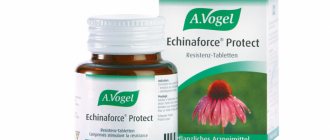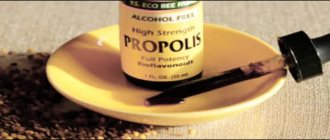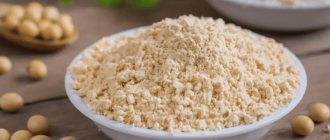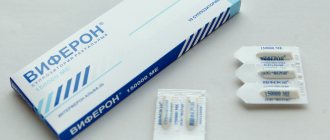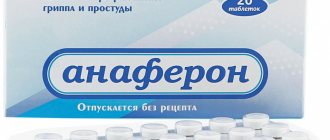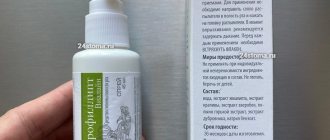Composition and release form
The drug is available in the form of tablets and syrup for oral administration. The tablets are white, coated with a special soluble coating. Packed in cardboard packaging up to 100 pieces.
Syrup of uniform color and consistency. Sold in dark glass bottles of 50, 60 or 100 ml.
The active substance of the drug is bromhexine. Its content in tablets and syrup varies from 4 to 8 mg. Auxiliary components: sucrose, pure water, ethyl alcohol, polysorbate, sodium hydrogen phosphate, eucalyptus oil.
Bromhexine solution for oral administration
Release form
Oral solution . Transparent, colorless or yellowish, slightly viscous liquid with a characteristic fruity odor.
Compound
Active ingredient : bromhexine hydrochloride (4 mg/5 ml).
Excipients : propylene glycol, sorbitol, aromatic substance concentrate (apricot), hydrochloric acid solution, purified water.
(!) Alcohol-free.
Production
Tula Pharmaceutical Factory (Russia)
Package
From 10 to 250 ml in a bottle of dark glass or plastic, bottle in a cardboard box. A measuring cup or measuring spoon is placed in the packaging.
Pharmacological group
Mucolytic and expectorant drug
Action
Mucolytic (secretolytic), expectorant, weak antitussive.
Bromhexine: description of the substance
Indications
Acute and chronic bronchopulmonary diseases accompanied by the formation of high-viscosity sputum (bronchial asthma, pneumonia, tracheobronchitis, obstructive bronchitis, bronchiectasis, pulmonary emphysema, cystic fibrosis, tuberculosis, pneumoconiosis).
Sanitation of the bronchial tree in the preoperative period and during therapeutic and diagnostic intra-laboratory manipulations, prevention of accumulation of thick viscous sputum in the bronchi after surgery.
Application and dosage
Inside. Dosing is carried out using a measuring cup or measuring spoon.
- Adults and children over 10 years of age: 10–20 ml 3 times a day (daily dose – 24–48 mg of bromhexine).
- Children from 6 to 10 years old, as well as patients weighing less than 50 kg: 5-10 ml 3 times a day (daily dose - 12-24 mg of bromhexine).
- Children from 3 to 6 years old: 2.5–5 ml 3 times a day (daily dose – 12 mg of bromhexine).
Contraindications and restrictions
- Hypersensitivity to bromhexine and other components of the drug.
- Pregnancy and breastfeeding period.
- Peptic ulcer (in the acute stage).
- Children under 3 years of age.
- Hereditary fructose intolerance (since the drug contains sorbitol).
with caution in patients with a history of gastric bleeding, bronchial diseases accompanied by excessive accumulation of secretions, a history of episodes of hemoptysis, renal and/or liver failure, children aged 3 to 6 years.
special instructions
During treatment, it is necessary to take a sufficient amount of fluid, which increases the expectorant effect.
In cases of impaired bronchial motility or with a significant volume of sputum secreted (for example, in rare malignant ciliary syndrome), the use of bromhexine requires caution due to the risk of retention of secretions in the respiratory tract.
Instructions for patients with diabetes: 5 ml of solution contains 1.5 g of sorbitol, which corresponds to 0.12 bread units.
Side effect
From the gastrointestinal tract: abdominal pain, dyspepsia, incl. nausea, vomiting, exacerbation of gastric and duodenal ulcers.
Allergic reactions: hypersensitivity reactions (skin rash, itching, angioedema, rhinitis), urticaria, fever, anaphylactic reactions, including anaphylactic shock.
From the skin and subcutaneous tissues: Stevens-Johnson syndrome, Lyell's syndrome, acute generalized exanthematous pustulosis.
Other: dizziness, headache, increased activity of “liver” transaminases in the blood serum.
Sorbitol
Bromhexine solution contains sorbitol. Sorbitol may also have a mild laxative effect.
In patients with sorbitol/fructose intolerance, under the influence of sorbitol contained in the drug, the following may also be observed: nausea, vomiting and diarrhea, decreased blood sugar levels (accompanied by trembling, cold sweat, palpitations, a feeling of fear), increased activity of “liver” transaminases.
Storage
Store out of the reach of children at room temperature 15–25 °C. Shelf life: 3 years.
Recipe
Available without a prescription.
pharmachologic effect
The drug has a number of therapeutic properties, providing mucolytic, expectorant and antitussive effects.
Effective against dry cough in adults and children. Due to its special composition, its ability to liquefy and remove mucus from the bronchopulmonary system is noted. The drug stimulates the production of a special substance that settles on the surface of the respiratory organs and helps protect them.
Bromhexine is quickly adsorbed in the body. After oral administration, the pharmacological properties develop after 30-60 minutes. The drug products are eliminated through the liver and excretory organs in an average of 12-15 hours.
What does Bromhexine help with?
Indications for taking Bromhexine are:
- Bronchiectasis.
- Tuberculosis.
- Bronchitis, predominantly obstructive.
- Cystic fibrosis.
- Pneumonia.
- Emphysema.
- Bronchial asthma.
In addition, the drug is prescribed before and after surgery to sanction the respiratory system and conduct diagnostic procedures.
Contraindications
The drug is contraindicated for use in the following cases:
- Ulcerative processes of the gastrointestinal tract in the acute period.
- Children under 2 years old.
- Breast-feeding.
- Individual intolerance to the drug.
- Allergy to sucrose.
- Women during pregnancy in the first trimester.
Bromhexine should be prescribed with caution to persons with impaired renal and liver function, diabetes mellitus, a large accumulation of exudate in the bronchopulmonary system, and pregnancy in the 2nd and 3rd trimester.
Buy Bromhexine solution for internal use 4mg/5ml 60ml Berlin-Chemie in pharmacies
Bromhexine 4 Berlin-Chemie Buy Bromhexine 4 Berlin-Chemie in pharmacies DOSAGE FORMS solution 4mg/5ml solution for internal use 4mg/5ml
MANUFACTURERS Berlin-Chemie AG (Germany) Berlin-Chemie AG/Menarini Group (Germany)
GROUP Mucolytic agents
COMPOSITION Active ingredient: Bromhexine.
INTERNATIONAL NON-PROPENTED NAME Bromhexine
SYNONYMS Bisolvon, Bromhexine, Bromhexine 8, Bromhexine 8 Berlin-Chemie, Bromhexine Nycomed, Bromhexine-Acri, Bromhexine-UBF, Bromhexine hydrochloride, Bronchosan, Bronchotil, Solvin, Phlegamine
PHARMACOLOGICAL ACTION Mucolytic, expectorant, antitussive. Causes depolarization of mucoprotein and mucopolysaccharide polymer molecules (mucolytic effect). Stimulates the production of endogenous surfactant, which ensures the stability of alveolar cells during breathing, their protection from unfavorable factors, improving the rheological properties of bronchopulmonary secretion, its sliding along the epithelium and the release of sputum from the respiratory tract. When taken orally within 30 minutes, it is almost completely absorbed. In plasma it binds to proteins. Penetrates through the BBB and placental barriers. In the liver it undergoes demethylation and oxidation. Excreted by the kidneys. May accumulate with repeated use.
INDICATIONS FOR USE Acute and chronic diseases of the bronchi and lungs with impaired sputum discharge.
CONTRAINDICATIONS Hypersensitivity, pregnancy (especially in the first trimester), breastfeeding (must be suspended for the period of treatment).
SIDE EFFECTS Gastrointestinal disorders (nausea, vomiting, dyspepsia, exacerbation of peptic ulcer), increased aminotransferase activity, allergic skin reactions, angioedema.
INTERACTION Codeine -containing drugs make it difficult to clear liquefied sputum. Promotes the penetration of antibiotics (erythromycin, cephalexin, oxytetracycline) into the lung tissue.
METHOD OF APPLICATION AND DOSAGE Orally, with liquid. Adults and adolescents over 14 years old - 23-47 drops 3 times a day; children from 6 to 14 years old and patients whose body weight is below 50 kg - 23 drops 3 times a day, up to 6 years - 12 drops 3 times a day. Patients with severe renal failure should reduce the single dose or increase the interval between doses.
OVERDOSE No data available.
SPECIAL INSTRUCTIONS Prescribed with caution for peptic ulcers of the stomach and duodenum.
STORAGE CONDITIONS List B. In a place protected from light at room temperature.
Side effects
Taking an antitussive drug may cause side effects. They develop when the course or therapeutic dose is not followed. The most commonly observed conditions are:
- Nausea followed by vomiting.
- Headache.
- Dizziness.
- Increased activity of liver enzymes.
- Exacerbation of ulcerative pathologies of the gastrointestinal tract.
- Allergic reactions - hyperemia, swelling, itching, skin rashes.
- Pain in the epigastric region, stool disturbance.
How to take Bromhexine for adults
The product must be used as directed by a specialist. The dosage and duration of the course depend on the diagnosis, general health and age of the patient.
Adult patients are prescribed the drug in different forms. Tablets should be taken regardless of food, 1-2 tablets up to 4 times a day, with a sufficient volume of water.
The medicine in the form of syrup is drunk according to a similar scheme as tablets. The recommended dosage is 8-16 mg 3-4 times a day.
The duration of treatment with Bromhexine is at least 4 days, maximum 4 weeks. It is important to maintain water balance while using the drug.
Bromhexine syrup 4 mg/5 ml 100 g apricot in Yekaterinburg
Latin name
Bromhexine
International nonproprietary name
Bromhexine*
Release form
Syrup
Package
Bottle 100 ml. 100 ml
Description
Transparent, colorless or yellowish liquid, slightly viscous with a fruity odor.
pharmachologic effect
The drug has a mucolytic (secretolytic) and expectorant effect. The mucolytic effect is associated with depolymerization and liquefaction of mucoprotein and mucopolysaccharide fibers. Bromhexine has a weak antitussive effect. Stimulates the production of endogenous surfactant, which ensures the stability of alveolar cells during respiration. The clinical effect appears within 2-5 days from the start of treatment with the drug.
Indications
Bronchopulmonary diseases accompanied by the formation of high-viscosity sputum (bronchial asthma, cystic fibrosis, tuberculosis, pneumonia, tracheobronchitis, obstructive bronchitis, bronchiectasis, pulmonary emphysema, pneumoconiosis), chest injuries, pre- and postoperative period.
Directions for use and doses
Bromhexine is taken orally regardless of food intake. The solution is prescribed to adults and children over 14 years of age, 8-16 mg (20 ml) 3-4 times a day. Children under 2 years of age - 2 mg (2.5 ml) 3 times a day, from 2 to 6 years - 2-4 mg (2.5-5 ml) 3 times a day, from 6 to 14 years - 4- 8 mg (5-10 ml) 3 times a day. The course of treatment is from 4 to 28 days. During treatment, it is recommended to consume a sufficient amount of fluid, which supports the secretolytic effect of bromhexine. In children, treatment should be combined with postural drainage or vibration massage of the chest, which facilitates the evacuation of secretions from the bronchi.
Compound
5 ml of solution contains: Active substance: bromhexine hydrochloride - 4 mg. Excipients: propylene glycol - 25 g, sorbitol - 40 g, apricot-scented aromatic concentrate - 0.05 g, hydrochloric acid 0.1 M (3.5% solution) - 0.156 g, purified water - 49.062 g.
Contraindications
- hypersensitivity to the components of the drug; — pregnancy (1st trimester); - lactation period; - peptic ulcer (in the acute stage)
Use during pregnancy and breastfeeding
The use of the drug during pregnancy is possible only if the expected benefit to the mother outweighs the possible risk to the fetus. The use of the drug during lactation is contraindicated.
special instructions
During treatment, it is necessary to take a sufficient amount of fluid, which increases the expectorant effect. The half-life of bromhexine increases with severe renal impairment. Therefore, patients with impaired renal function should be prescribed bromhexine in lower doses or in usual doses, but at longer intervals. In cases of impaired bronchial motility or with a significant volume of sputum secreted (for example, in rare malignant ciliary syndrome), the use of Bromhexine 4 Berlin-Chemie requires caution due to the risk of retention of secretions in the respiratory tract. The use of Bromhexine 4 Berlin-Chemie in children under 2 years of age is possible only under the supervision of a physician. Instructions for patients with diabetes: 5 ml of solution (1 scoop) contains 2 g of sorbitol, which corresponds to 0.17 bread units.
Side effects
Possible: nausea, vomiting, dyspepsia, exacerbation of peptic ulcer. Rarely: allergic reactions develop (skin rash, rhinitis, swelling), shortness of breath, fever and chills, anaphylactic shock, dizziness and headaches, increased levels of transaminases in the blood serum. In patients with sorbitol/fructose intolerance, under the influence of sorbitol contained in the drug Bromhexine 4 Berlin-Chemie, the following may also be observed: nausea, vomiting and diarrhea, decreased blood sugar levels (accompanied by trembling, cold sweat, palpitations, a feeling of fear), increased activity liver transaminases (extremely rare). If side effects occur, stop taking the drug and consult a doctor.
Drug interactions
Bromhexine can be prescribed simultaneously with other drugs used in the treatment of bronchopulmonary diseases. Bromhexine is not prescribed simultaneously with medications containing codeine, as this makes it difficult to clear liquefied sputum. Bromhexine promotes the penetration of antibiotics (erythromycin, cephalexin, oxytetracycline) into the lung tissue. Bromhexine is not compatible with alkaline solutions.
Storage conditions
Store out of the reach of children at a temperature not exceeding 25C.
How to take Bromhexine for children
The medicine is widely used to treat children. Syrup is given to children from 2 years old, tablets from 6 years old.
The drug is taken according to the following scheme, depending on age:
- 2-6 years - 2.5-5 ml of the drug per day is recommended;
- 6-10 years - 5-10 ml of syrup;
- over 10 years old - 10 ml 3 times a day;
- 6-14 years old are prescribed 8 mg of Bromhexine per day in tablet form.
The pharmacological effect usually occurs after 4 days. For better and easier removal of sputum, you should simultaneously massage and give the child the required amount of liquid.
Bromhexine syrup
Release form
Syrup 8 mg/5 ml or syrup 4 mg/5 ml. Transparent, colorless or slightly yellowish with the smell of vanillin.
Compound
Active ingredient : bromhexine hydrochloride (80 mg or 160 mg per 100 ml of syrup).
Excipients : propylene glycol, sodium benzoate, food grade sorbitol, citric acid monohydrate, saccharin (sodium saccharinate), vanillin, purified water.
Production
- ROZFARM, LLC (Russia)
- ROZLEKS PHARM, LLC (Russia)
- Scan Biotech Ltd. (India)
Package
Syrup for oral administration, 50 ml or 100 ml in dark bottles made of polyethylene terephthalate or glass. Each bottle is placed together with instructions for use, a 5 ml measuring spoon or a 5 ml measuring cup in individual cardboard packs.
Pharmacological group
Mucolytic and expectorant drug
Action
Secretomotor, secretolytic, weak antitussive.
Bromhexine: description of the substance
Indications
Acute and chronic diseases of the respiratory tract, accompanied by difficulty in the discharge of viscous sputum: tracheobronchitis, bronchitis of various etiologies (including complicated by bronchiectasis), pneumonia, bronchial asthma, pulmonary tuberculosis, cystic fibrosis.
Sanitation of the bronchial tree in the preoperative period and during therapeutic and diagnostic intrabronchial manipulations, prevention of accumulation of thick viscous sputum in the bronchi after surgery.
Application and dosage
Inside. 1 measuring spoon or 1 measuring cup contains 5 ml of syrup.
Syrup 8 mg/5 ml is prescribed:
- adults and children over 14 years old, 8–16 mg (5–10 ml) 3 times a day,
- children 6–14 years old - 8 mg (5 ml) 3 times a day.
Syrup 4 mg/5 ml is prescribed to children in the following doses:
- up to 2 years 2 mg (2.5 ml) 3 times a day,
- 2–6 years - 4 mg (5 ml) 3 times a day,
- 6–14 years - 8 mg (10 ml) 3 times a day.
Contraindications and restrictions
Hypersensitivity, peptic ulcer of the stomach and duodenum, pregnancy (first trimester), lactation period, children under 6 years of age (for syrup 8 mg/5 ml).
With caution : renal failure, liver failure, bronchial diseases accompanied by excessive accumulation of secretions, a history of gastrointestinal bleeding.
Side effects
Allergic reactions, nausea, vomiting, dyspepsia, exacerbation of gastric and duodenal ulcers, dizziness, headache, increased activity of liver transaminases (extremely rare).
Overdose
Symptoms: nausea, vomiting, diarrhea and other dyspeptic disorders. Treatment: artificial vomiting, gastric lavage (in the first 1–2 hours after administration).
special instructions
During treatment, it is necessary to consume a sufficient amount of fluid, which increases the expectorant effect of bromhexine.
Treatment should be combined with postural drainage or vibration massage of the chest, which facilitates the removal of secretions from the bronchi.
Bromhexine does not contain sugar; the syrup contains sweeteners, so it can be used in patients with diabetes and obesity.
Storage
Store in a dry place, protected from light, out of reach of children, at room temperature not lower than 15°C. Shelf life: 3 years.
Recipe
Available without a prescription.
special instructions
The drug is used with extreme caution for bronchial asthma, especially during exacerbation.
Patients with ulcerative processes of the digestive tract and bleeding from the gastrointestinal tract should take the medication under the supervision of a physician.
It is not recommended to combine the medicine with codeine. Because it interferes with the liquefaction and coughing up of sputum.
Brombexine is best taken together with natural combined action products that contain essential oils (eucalyptus, anise, peppermint or menthol).
Bromhexine 4mg/5ml 100ml Apricot syrup
Release form: Syrup
Packaging: Bottle 100 ml.
Composition: 5 ml of syrup contains: Active substance: bromhexine hydrochloride – 4 mg.
pharmachologic effect
Bromhexine has a mucolytic (secretolytic) and expectorant effect. The mucolytic effect is associated with depolymerization and liquefaction of mucoprotein and mucopolysaccharide fibers. Bromhexine has a weak antitussive effect. Stimulates the production of endogenous surfactant, which ensures the stability of alveolar cells during respiration. The clinical effect appears within 2-5 days from the start of treatment with the drug.
Pharmacokinetics
When taken orally, bromhexine is almost completely (99%) absorbed within 30 minutes. Bioavailability is 20-25% (the “first pass” effect through the liver). In plasma, bromhexine binds 95% tightly to proteins and penetrates the blood-brain and placental barriers. In the liver, bromhexine undergoes demethylation and oxidation. The half-life is 15 hours due to slow reverse diffusion from tissues. Excreted by the kidneys. In chronic renal failure, the release of bromhexine metabolites is impaired. With repeated use, bromhexine may accumulate.
Indications
Chronic inflammatory lung diseases (bronchial asthma, cystic fibrosis, tuberculosis, tracheobronchitis, spastic bronchitis, bronchiectasis, emphysema, pneumoconiosis), chest injuries, pre- and postoperative period.
Contraindications
Pregnancy (1st trimester), childhood (up to 3 years). Use during pregnancy and lactation During pregnancy and lactation, bromhexine is used in cases where the expected benefit to the mother outweighs the potential risk to the fetus or child.
special instructions
For gastric ulcers, as well as when there is a history of gastric bleeding, bromhexine should be used under the supervision of a physician. Use with caution in patients suffering from bronchial asthma. Bromhexine is not used simultaneously with medications containing codeine, because this makes it difficult to cough up thin mucus. Used as part of combination preparations of plant origin with essential oils (including eucalyptus oil, anise oil, peppermint oil, menthol).
Directions for use and doses
Orally, 3 times a day, with water if necessary. Adults and adolescents over 14 years of age: 8–16 mg or 2–3 teaspoons. Children from 6 to 14 years old: 4–8 mg or 1–2 teaspoons. Children under 6 years old: syrup is recommended, up to 2 years old - 1/2 teaspoon, from 2 to 6 years old - 1/2–1 teaspoon.
Side effects
From the digestive system: dyspeptic symptoms, transient increase in the activity of liver transaminases in the blood serum. From the side of the central nervous system: headache, dizziness. Dermatological reactions: increased sweating, skin rash. From the respiratory system: cough, bronchospasm.
Drug interactions
Bromhexine can be prescribed simultaneously with other drugs used in the treatment of bronchopulmonary diseases. Bromhexine is not prescribed simultaneously with antitussives (including those containing codeine), because they may make it difficult to cough up sputum diluted with Bromhexine. Bromhexine promotes the penetration of antibiotics (amoxicillin, erythromycin, cephalexin, oxytetracycline), sulfonamide drugs into bronchial secretions in the first 4-5 days of antimicrobial therapy. Bromhexine is not compatible with alkaline solutions.
Overdose: Symptoms: nausea, vomiting, diarrhea, dyspeptic disorders. Treatment: artificial vomiting, gastric lavage (in the first 1-2 hours after administration).
Storage conditions: Store at room temperature up to 25°C. Keep out of the reach of children.
Shelf life: 5 years
